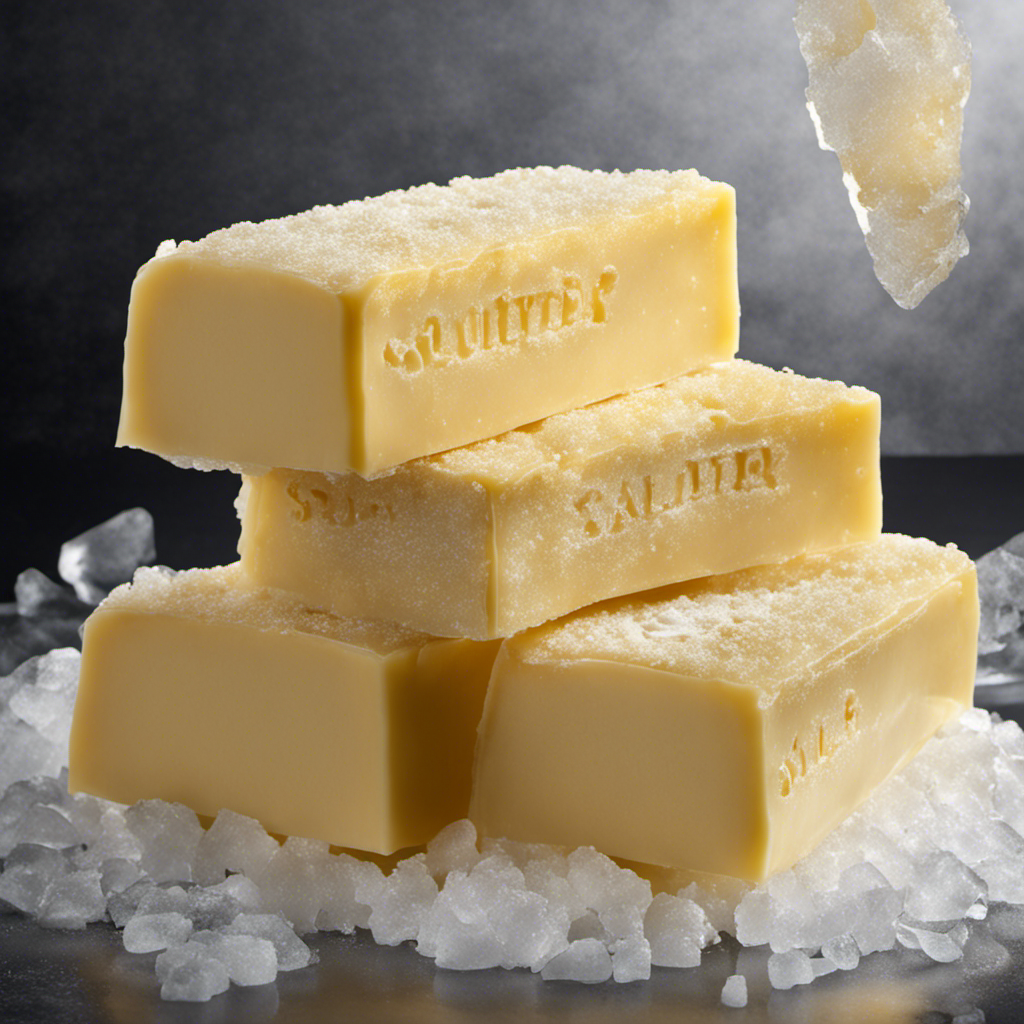Have you ever thought about how long salted butter can be frozen for? If you have, you’ve come to the right spot. This article will delve into the freezer life of salted butter and offer you suggested storage durations.
We will also discuss the factors that can affect the freezing quality of salted butter and share proper packaging techniques. Plus, we’ll give you tips for thawing and using frozen salted butter.
Get ready to preserve your butter for longer with our expert advice.
Key Takeaways
- Frozen salted butter can last 9 to 12 months if stored properly.
- Up to 6 months of freezing time is recommended.
- Proper packaging techniques, such as vacuum sealing or using butter molds, can help maintain the quality and freshness of salted butter during freezing.
- Thaw frozen butter in the refrigerator overnight for gradual and even thawing, and use it in recipes by grating or cutting it into small pieces.
Shelf Life of Salted Butter in the Freezer
How long can you freeze salted butter without it going bad?
The shelf life of frozen salted butter is about 9 to 12 months if stored properly. Freezing helps to preserve the quality and freshness of butter for an extended period.
To ensure the best results, it is recommended to wrap the salted butter tightly in an airtight container or freezer bag to prevent freezer burn.
When you are ready to use the frozen butter, it is important to thaw it properly. The recommended thawing method is to transfer the butter from the freezer to the refrigerator and let it thaw slowly for 24 to 48 hours. Avoid thawing at room temperature or in the microwave, as this can affect the texture and taste.
Additionally, frozen salted butter can be used as a flavor enhancer in cooking or baking, or even spread on toast straight from the freezer.
Recommended Storage Time for Frozen Salted Butter
To maintain the quality of frozen salted butter, it’s best to store it for a recommended period of time. Following the proper storage guidelines ensures that the butter retains its flavor and texture when thawed. Here are the recommended freezing times and best practices for frozen salted butter:
| Freezing Time | Best Practices |
|---|---|
| Up to 6 months | – Wrap the butter tightly in plastic wrap or aluminum foil to prevent freezer burn. |
- Store the wrapped butter in an airtight container or freezer bag to further protect it from odors and moisture.
- Label the container with the date of freezing to keep track of its freshness.
- Place the butter in the coldest part of the freezer, away from other strong-smelling foods.
- Thaw the butter in the refrigerator for 24 hours before using. |
Factors Affecting the Freezing Quality of Salted Butter
Factors that can affect the freezing quality of salted butter include temperature fluctuations, exposure to air, and improper packaging.
When it comes to freezing salted butter, it is important to consider the impact it can have on its flavor and texture.
Freezing can affect the flavor of salted butter, causing it to become slightly milder over time. The salt content in the butter can also impact the texture of the frozen product.
Higher salt content can lead to a slightly drier texture when frozen, while lower salt content can result in a creamier texture.
It is important to note that while freezing can alter the flavor and texture of salted butter, it can still be safely stored in the freezer for an extended period of time if properly packaged and stored at a consistent temperature.
Proper Packaging Techniques for Freezing Salted Butter
When properly packaged, salted butter can maintain its quality and flavor while being stored in the freezer. To ensure the best results, it is essential to use appropriate packaging techniques such as vacuum sealing and butter molds. Vacuum sealing involves removing all the air from the packaging, which helps prevent freezer burn and maintain the butter’s freshness. Butter molds, on the other hand, help shape and protect the butter during freezing. By using these techniques, you can extend the shelf life of salted butter and preserve its taste and texture for a longer period. It is important to note that when thawing frozen butter, it is recommended to do so in the refrigerator to ensure a gradual and even thawing process.
| Packaging Technique | Benefits |
|---|---|
| Vacuum Sealing | Prevents freezer burn and maintains freshness |
| Butter Molds | Shapes and protects the butter during freezing |
Tips for Thawing and Using Frozen Salted Butter
One convenient way to thaw and use frozen salted butter is by placing it in the refrigerator overnight. This slow thawing technique allows the butter to gradually come to room temperature without compromising its texture or flavor.
It is important to note that frozen butter should never be thawed at room temperature or in the microwave, as it can lead to uneven melting and alter the butter’s consistency.
When baking with frozen butter, it is best to grate or cut it into small pieces before incorporating it into the recipe. This ensures even distribution throughout the dough or batter. Additionally, using frozen butter in baking can result in flakier pastries and a crumblier texture in cookies.
However, keep in mind that the butter may take slightly longer to incorporate into the mixture, so be patient and mix thoroughly to achieve the desired consistency.
Conclusion
Congratulations, butter enthusiasts! You now possess the knowledge to unlock the secrets of freezing salted butter. Armed with this information, you can extend the shelf life of your beloved dairy delight and ensure its frozen glory for months on end.
Remember, proper packaging is key, as is a gentle thawing process. So, go forth and freeze with confidence, for the buttery possibilities are endless!










